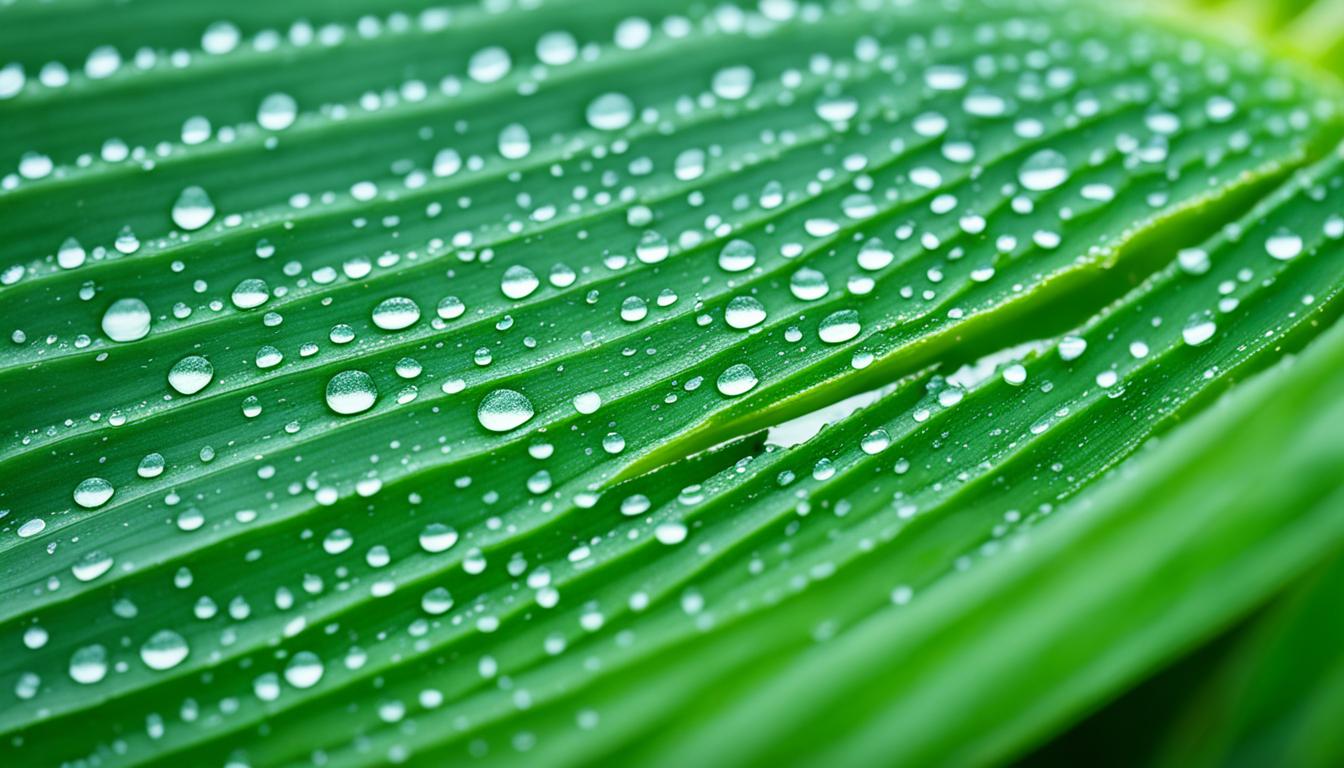Did you know Aloe Vera is more than just a pretty plant? It’s a healer! For centuries, people have used it for its healing power. Now, it’s popular in homes for its looks and health benefits. This guide will show you how to grow and care for Aloe Vera.
Everything from Aloe Vera’s benefits to how to grow it is here. You’ll learn about care, making more plants, and dealing with bugs. Let’s turn your home into a green, healthy space with Aloe Vera!
Key Takeaways:
- Learn how Aloe Vera can enhance the aesthetics and air quality of your apartment.
- Discover the essential tips for growing Aloe Vera indoors, including potting, watering, and lighting requirements.
- Explore various propagation methods to expand your Aloe Vera collection.
- Identify common pests and diseases that can affect Aloe Vera and learn effective prevention and treatment strategies.
- Gain insights into the growth and development of Aloe Vera, from seed to mature plant.
Why Do We Love the Aloe Vera For Apartments?
Aloe Vera is quickly becoming a favorite houseplant for those living in apartments. It’s loved for its air-cleaning abilities, being safe for pets, and its indoor size.
Is Aloe Vera Air-Purifying?
Aloe Vera is known for making the air clean. It takes away bad pollutants like formaldehyde and benzene. This plant also gives off oxygen and takes in carbon dioxide at night. So, it’s great for bedrooms, helping you sleep well.
Is Aloe Vera Pet Friendly?
For people with pets, Aloe Vera is mostly safe. But, if pets eat a lot of it, they might get a stomach upset. Always watch your pets around the plant. If you’re worried your pet ate too much, talk to a vet.
How Big Does Aloe Vera Get?
Grown indoors, Aloe Vera doesn’t get too big. Perfect for small spaces. Mature plants can be two to three feet tall. They look great on counters, windowsills, or shelves. They add green without taking up too much space.
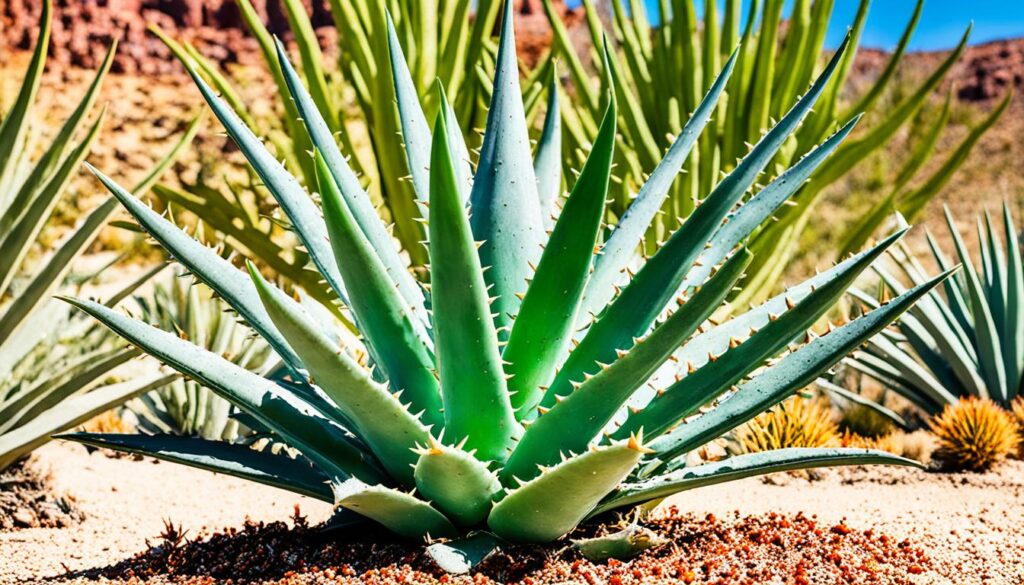
How to Grow Aloe Vera – Learn to Grow this Indoor Beauty
Growing Aloe Vera inside needs careful care. People love it for its looks and health perks. Here, I’ll show you how to grow this helpful plant.
Choosing the Right Pot and Soil
For Aloe Vera, the pot and soil matter a lot. Pick a pot with good drainage that fits the plant size. Use soil that drains well, like cactus mix, to avoid root rot. Don’t use soil that holds too much water.
Providing Adequate Light
Aloe Vera loves bright, indirect sun. Put it near a window but away from direct sunlight to avoid leaf burn. It can adapt to many light conditions. Yet, too little light makes it grow poorly and look pale.
Watering and Humidity
Watering Aloe Vera right is crucial. Let the soil dry out well before watering. Water it well, then let the water drain. Aloe is a succulent that does well with less water. It likes dry air, not moist.
Nutrition and Fertilization
Aloe Vera isn’t needy for food. It mostly gets what it needs from soil and air. You can feed it lightly in the growing season with weak fertilizer. Feed it every few months. Too much fertilizer can harm it.
Pruning and Maintenance
Keep Aloe Vera looking good by pruning. Cut off bad leaves with clean shears. Look for and remove yellow or brown leaves. They mean there’s a problem. Always check for pests or diseases and act fast to stop them.
Propagation
Want more Aloe Vera plants? Use offshoots, or “pups,” for this. These grow at the base of the main plant. Once they have roots, plant them in good soil. Wait a few days after cutting before planting.
Monitoring for Pests and Diseases
Aloe Vera can get bugs and sicknesses. Watch out for aphids, mealybugs, and spider mites. Look for webbing or color changes on your plant. If you see bugs or sickness, act fast to protect your plant. Try safe pest control ways.
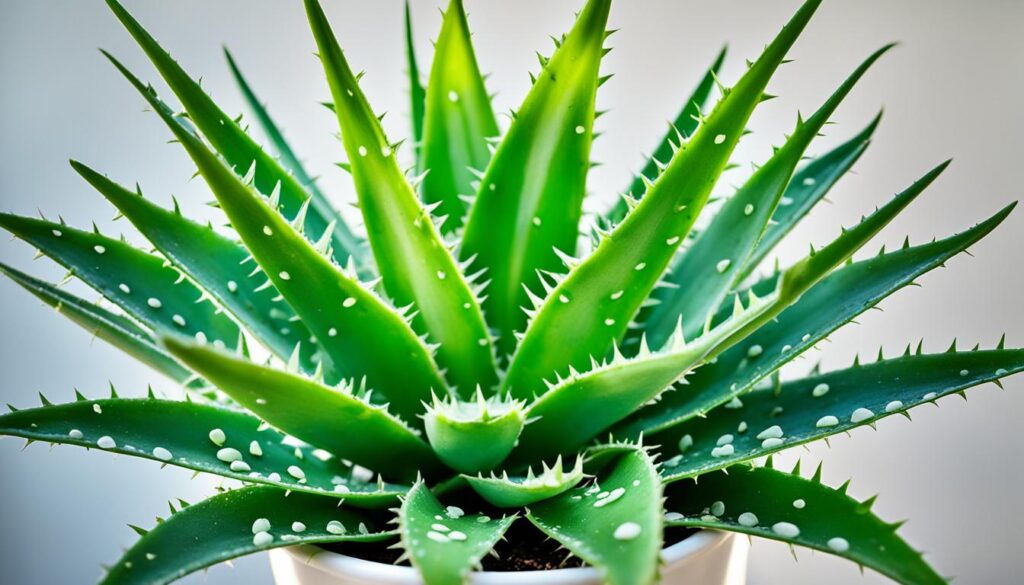
| Keyword | Definition |
|---|---|
| Aloe Vera | A succulent plant known for its healing properties and versatile uses. |
| Grow | The process of nurturing and cultivating plants to achieve optimal growth and health. |
| Indoor plant | A plant that is cultivated and grown indoors, typically for decorative or air-purifying purposes. |
| Pot | A container used for planting and nurturing plants. |
| Soil | The top layer of the Earth’s surface in which plants grow, consisting of mineral particles, organic matter, and various microorganisms. |
| Light | Electromagnetic radiation that is visible to the human eye and is essential for photosynthesis in plants. |
| Watering | The act of providing plants with water to maintain proper hydration. |
| Humidity | The amount of moisture present in the air, which can impact plant growth and health. |
| Nutrition | The process of providing essential nutrients to plants for their growth and development. |
| Fertilization | The addition of nutrients to the soil or plant to enhance growth and productivity. |
| Pruning | The act of selectively removing parts of a plant, such as stems or leaves, to shape and maintain its health. |
| Maintenance | The ongoing care and attention required to keep plants healthy and thriving. |
| Propagation | The process of reproducing plants by growing new individuals from existing ones. |
| Pests | Insects or other organisms that can cause damage or harm to plants. |
| Diseases | Abnormal conditions that can affect the health and growth of plants, caused by pathogens or environmental factors. |
Appearance of Aloe Vera
Aloe Vera is known for its unique look. It has long, succulent leaves.
These leaves are spiky on the edges. Inside, there is a gel-like substance.
This gel is famous for healing. It’s used in skincare and natural cures.
Aloe Vera comes in various types. Each type looks a bit different.
Some may have leaves that are different colors or sizes. These make Aloe Vera great for gardens.
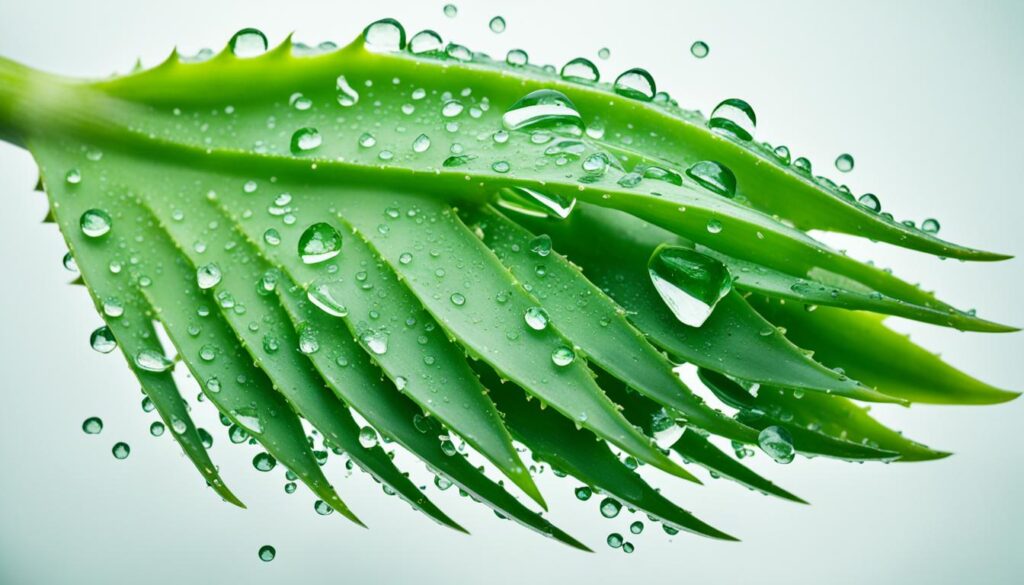
Light Requirements for Aloe Vera
Adequate light is key for Aloe Vera’s growth. It needs good sunlight to do well indoors. In this part, I’ll talk about what light Aloe Vera needs. I’ll also give tips to make sure it gets enough light inside.
Aloe Vera likes a lot of light but not too much. It does best in bright, indirect light. It’s good to put it near a south or west window. This way, it gets light all day. But, be careful of very strong, noon sun. It can hurt the leaves.
If you don’t have much natural light, you can use lamps. Use lights made for plants. Put them about 12 inches above your Aloe Vera. Keep them on for 12-16 hours a day. This is like the light outside.
You need to watch your plant for light problems. If it doesn’t get enough light, it might look stretched and pale. If it gets too much light, the leaves might turn brown or red. They might even look burned. Move your plant to fix its light problems.
In short, Aloe Vera needs bright light but not all-day direct sun. You can use plant lights if needed. Watch your plant for too little or too much light.
Watering Requirements of the Aloe Vera
Proper watering helps your Aloe Vera plant stay healthy and grow. Here, you’ll learn how much water Aloe Vera needs. You’ll also learn to spot when it’s too wet or dry. This way, your Aloe Vera will get just the right amount of water it needs to grow well.
Signs of Overwatering vs. Underwatering
Overwatering is bad for Aloe Veras. It can cause root rot and other issues. Look for these signs:
- Yellowing or wilting leaves
- Soggy or mushy leaves
- Foul odor
- Black or brown spots on leaves
- Pale or transparent leaves
Not giving enough water can also harm your Aloe Vera. It can get dehydrated and stop growing. Watch out for:
- Droopy or shriveled leaves
- Dry and brittle leaves
- Leaves turning brown or crispy
- Slow or no growth
Watch your plant to see if it needs more or less water.
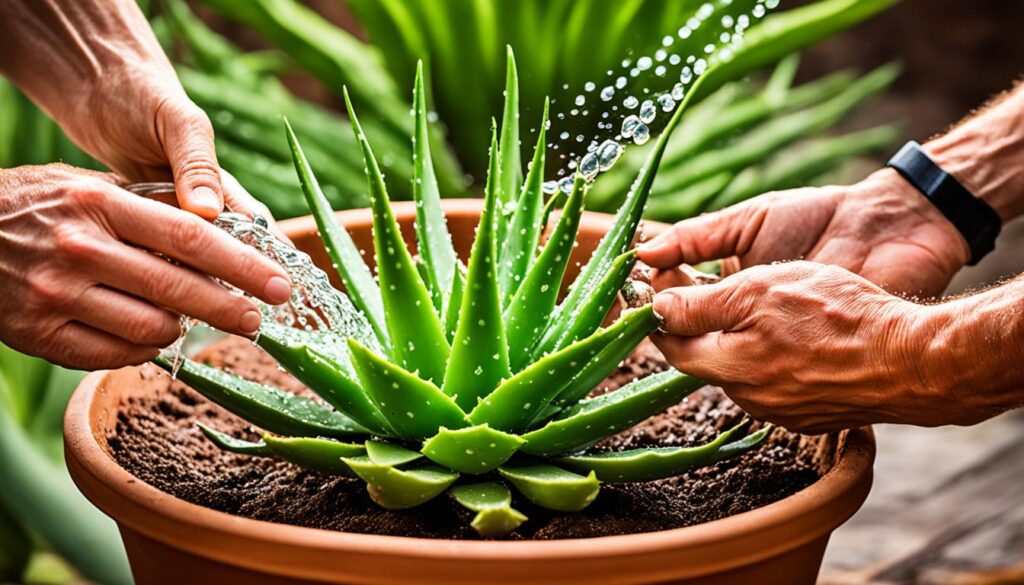
Fertilizing a Aloe Vera
Aloe Vera plants don’t need much care but like some food sometimes. Giving your Aloe Vera the right food helps it grow strong and look pretty. This part talks about why feeding Aloe Vera is good and which food is best. I’ll also tell you how often and how to give your plant its food.
Recommended Fertilizer for a Aloe Vera
Choosing the right food for Aloe Vera is important. Look for a special balanced food made for succulent plants. These foods usually have numbers like 10-10-10 or 10-24-12 on them. These numbers tell you about the good stuff in the food, like nitrogen, phosphorus, and potassium. A balanced food makes sure your Aloe Vera gets what it needs to be healthy.
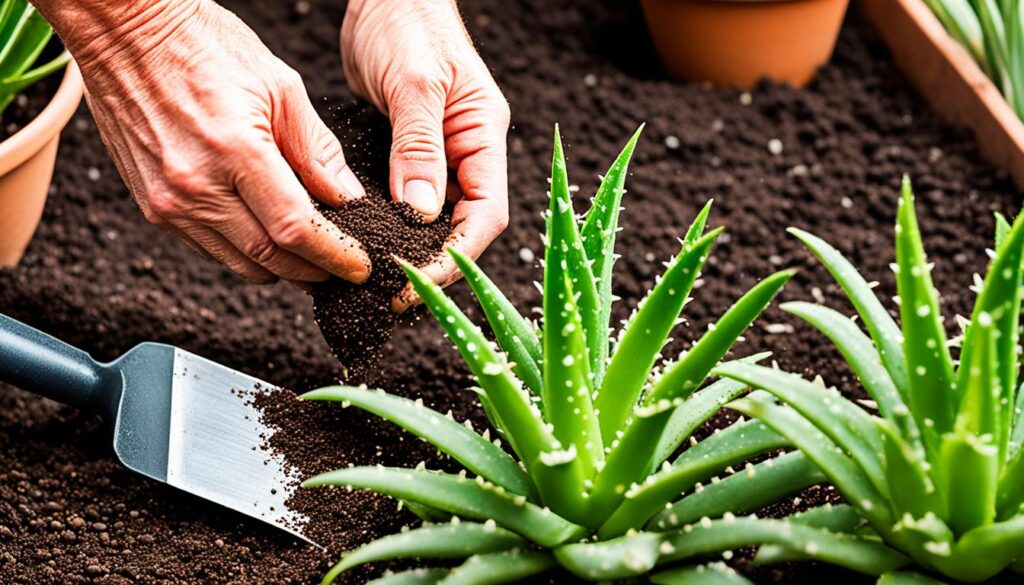
Potting a Aloe Vera
Proper potting helps Aloe Vera plants stay healthy and grow well. There are several key things to think about to make sure your Aloe Vera thrives.
Choosing the Right Pot Size
The size of the pot for your Aloe Vera is very important. It shouldn’t be too small or too big. A small pot can stop the roots from growing. A big pot might cause too much water.
Try to find a pot that’s just a bit bigger than the plant’s roots. This gives the roots room to grow.
Using the Right Potting Mix for a Aloe Vera
The potting mix you use for Aloe Vera matters a lot. Pick a mix made for succulents and cacti. These mixes have things like peat moss and perlite or sand.
They help the water drain well so the roots don’t get too wet.
Repotting When Necessary
Sometimes, your Aloe Vera will need a new pot or fresh soil. This is important for its health. When the plant gets too big or the soil is old, it’s time to repot.
Do this in the spring or summer. Take the plant out gently, fix the roots, and put it in a new pot with new soil.
With the right pot size, good soil, and timely repotting, your Aloe Vera can grow strong and healthy.
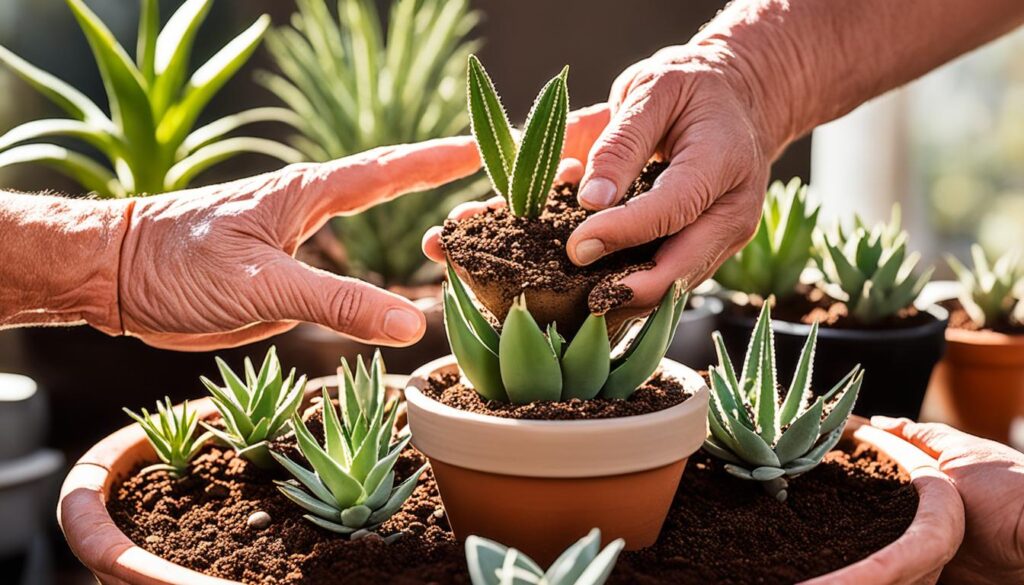
Propagating a Aloe Vera
Making new Aloe Vera plants is fun. You can grow your garden and give plants to friends. There are a few ways to do this. You can use parts of the plant or the seeds. Another way is to split a big Aloe Vera into smaller ones.
Stem Cuttings Or Seeds?
Using stem cuttings is easy and works well. First, pick a healthy leaf and cut it near the bottom. Let the cutting dry for some days. Then, put it in soil that drains well. Water it a little until it grows new parts.
Seeds are another choice. But Aloe Vera plants don’t make seeds often. If you find seeds, plant them in good soil. Remember, it might take a while for them to start growing.
Division Of A Aloe Vera
Splitting an Aloe Vera is a common way to get more plants. Take the plant out of its pot. Carefully split it into two or more pieces. Make sure each piece has plenty of roots. Put them in new pots and take good care of them.
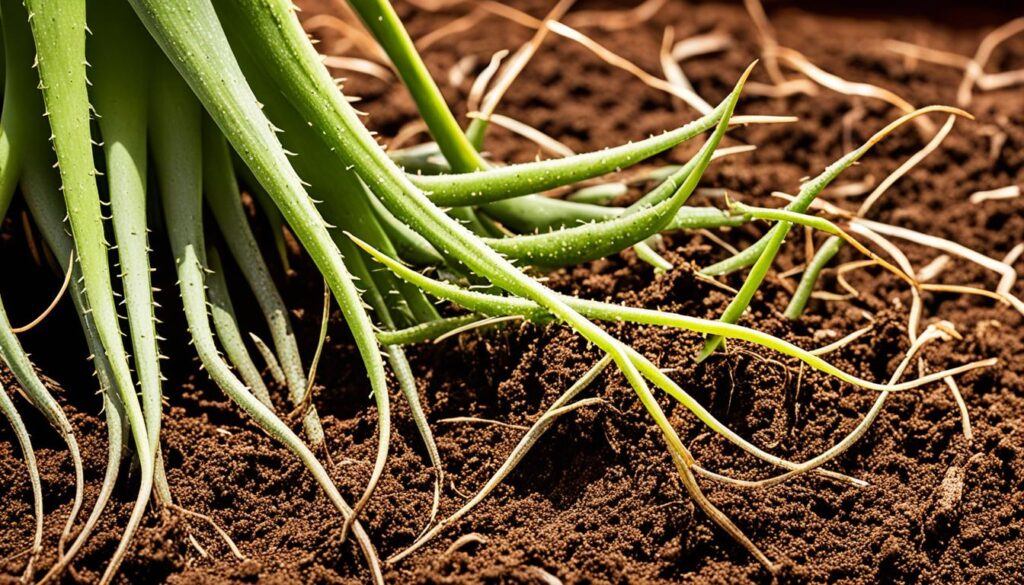
By propagating, you can have many Aloe Vera plants. You can use cuttings, seeds, or split the plants. Each way is special and helps you grow your collection.
Growth and Development of the Aloe Vera
Aloe Vera is a special plant with a fascinating life story. It grows and changes in amazing ways. Each stage of its life, from seed to full-grown plant, is unique.
The journey starts when Aloe Vera seeds are planted. These tiny seeds can turn into big plants. With good soil, enough light, and water, seeds begin to grow.
As the Aloe Vera gets older, it begins to look how we expect. Its leaves get big, green, and juicy. The edges become spiky, making the plant stand out.
The speed at which Aloe Vera grows can change. It depends on things like weather, light, and how you care for it. If everything is just right, it can grow to 24 inches tall.
Aloe Vera keeps growing new leaves from its center. This keeps the plant strong and looking good.
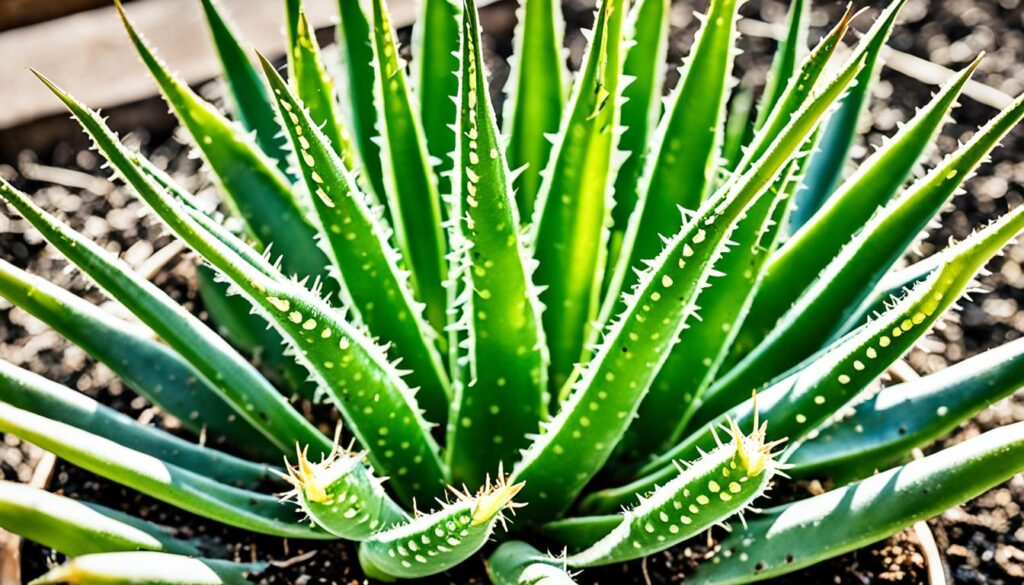
Knowing how Aloe Vera grows helps us take care of it better. We need to give it the right light, water, and food. This helps it stay healthy and look beautiful.
Dealing with Pests and Diseases in the Aloe Vera
Aloe Vera can get sick like any other plant. You need to keep your Aloe Vera plant healthy. We will talk about common pests and diseases. And how to keep your plant safe.
Common Pests:
Pests can harm your Aloe Vera. You might see bugs like:
- Aphids
- Mealybugs
- Spider mites
These pests can hurt your Aloe Vera. They can make it grow slow, change color, or even kill it. It’s important to deal with them fast.
To fight these pests, know what they are. Then, you can pick the best way to stop them. I will show you how to keep your Aloe Vera safe.
Prevention and Treatment:
Stopping pests before they start is key. You can do things like:
- Check your plant for bugs often.
- Clean around your plant well.
- Make sure your plant has air around it and don’t water it too much.
- Keep sick plants away from healthy ones.
See bugs or webs on your plant? You need to act fast. Here’s what you can do:
- Natural Predators: Bring in good bugs like ladybugs. They eat the bad ones.
- Isolation: Keep sick plants away so others don’t get sick too.
- Chemical Treatment: If there are a lot of pests, you might need bug spray. Be sure to use it right.
Remember, stopping pests before they start is best. Keep an eye on your plant. This helps keep it healthy.
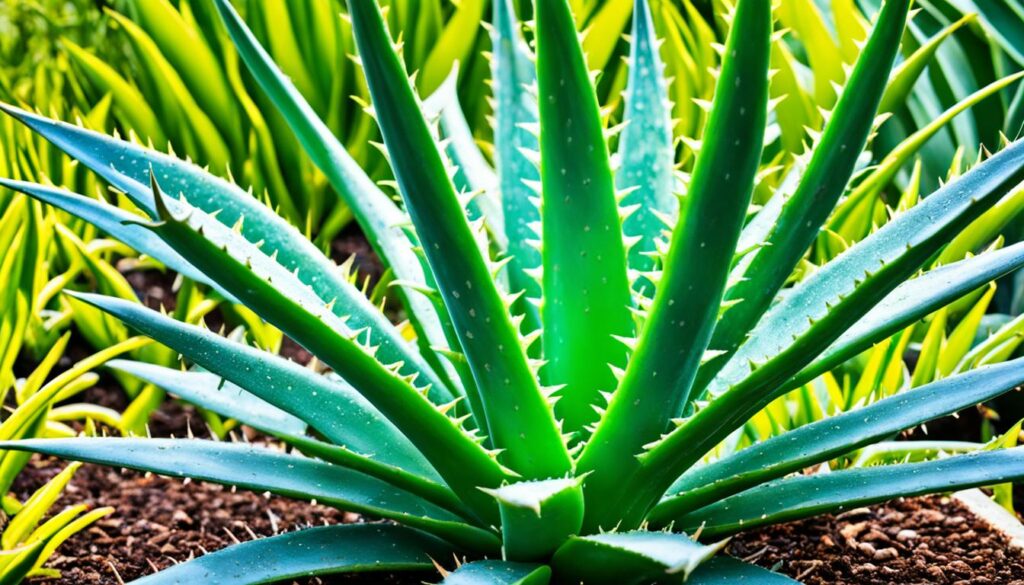
Common Aloe Vera Pests
Aloe Vera plants can get sick from different pests. Knowing these pests and how to fight them is key.
Here are three common pests that can affect Aloe Vera:
- Aphids: These tiny bugs suck on plant juice. They hang out on leaves and stems. They can make the plant grow slow, leaves curl, and turn yellow. You can fight aphids with bug-killing soap or spray them off with water.
- Mealybugs: Mealybugs are soft bugs with a white coat. They hide in leaf folds or under leaves. They drink sap and make leaves turn yellow, slow plant growth, and drop sticky stuff. To remove mealybugs, clean them with alcohol on a cotton swab or use bug soap.
- Spider Mites: These small pests are like spider family but not spiders. They eat plant juice, causing tiny dots, cobwebs, and leaf color changes. They love dry places. To fight spider mites, make the air moist, spray leaves, or use bug soap.
Check your plants often to find pests early. This stops big pest problems and keeps your Aloe Vera healthy. Good care like the right water, light, and cleaning helps fight off pests too.
Natural Predators
Controlling pests in Aloe Vera is important. Using natural predators and kind ways is key. These helpers, such as certain bugs and animals, keep pests away. They help us avoid bad chemicals.
To fight pests, add good bugs to your Aloe Vera garden. Bugs like ladybugs and lacewings eat pests like aphids and spider mites. This keeps pest numbers low. It makes a healthy garden.
Using isolation helps control pests too. If a plant gets sick, keep it away from healthy ones. This stops pests from spreading. It helps keep your Aloe Vera safe.
Sometimes, natural methods and isolation aren’t enough. Then, you might need chemicals. But be careful. Only use things made for Aloe Vera. Follow the instructions well.
| Pest | Natural Predator |
|---|---|
| Aphids | Ladybugs |
| Spider Mites | Lacewings |
| Mealybugs | Parasitic Wasps |
Disease Prevention For Aloe Veras
Preventing diseases in Aloe Vera plants is very important. To keep your Aloe Vera healthy, clean, and care for them well. Follow tips to cut down disease risks. This makes your Aloe Vera plants healthy and happy.
- Regularly clean your Aloe Vera: It’s important to keep your Aloe Vera clean. Gently wipe the leaves with a wet cloth to take off dust and dirt.
- Avoid overwatering: Aloe Vera likes soil that drains well. Be careful not to water too much. Too much water can harm the roots and make diseases more likely.
- Provide proper air circulation: Good air around your Aloe Vera stops diseases. Don’t put your plants too close together. They need space to breathe.
- Practice proper watering techniques: Water the base of your Aloe Vera, not the leaves. This stops water from collecting in the middle and stops fungal diseases.
- Inspect for pests regularly: Bugs can hurt your Aloe Vera and make it sick. Check your plant often for pests like aphids or spider mites. Deal with them quickly.
- Choose disease-resistant varieties: When picking Aloe Vera plants, choose ones that resist diseases. These types get sick less often and are easier to take care of.
Use these tips to prevent diseases in your Aloe Vera. Then, you can have healthy and strong plants at home or in your garden.
Tips for Maintaining Aloe Veras
Keeping your Aloe Vera plants healthy is important. Follow these simple tips for strong plants:
Wiping Leaves
Wipe the leaves of your Aloe Vera to remove dust or pests. This helps them absorb sunlight better. Use a soft cloth or sponge wisely. Take care not to harm the leaves.
Outdoor Exposure
Aloe Veras do well indoors but like some outdoor time. Be careful when taking them outside. They like bright places but not direct sun. Direct sun can burn their leaves.
Start by putting them outside for a few hours daily. Slowly increase the time over weeks. Watch how they handle being outside. Change your plan based on their needs.
Adjusting Watering Schedule
The watering needs for Aloe Veras change with the seasons. They might need more water when it’s warm. They need less when it’s cooler.
Check the soil before watering. If it’s dry, it’s time to water. But don’t water too much to avoid root rot. Watering should match the season and your plant’s needs.
Follow these tips for happy Aloe Vera plants. Clean leaves, careful outdoor time, and smart watering help a lot. Each step is key to their care!
Tips for Successful Overwintering of Aloe Vera
In colder regions, it’s key to overwinter Aloe Vera to keep your plants alive. When winter comes, Aloe Vera needs special care. Follow guidelines for winter care and keep them warm inside.
Here are some tips to successfully overwinter Aloe Vera:
- Move your Aloe Vera plants inside when it gets cold. Aloe Vera likes it warm. Bringing them inside keeps them safe.
- Aloe Vera needs light in winter too. Put them near a window for indirect sunlight. Use artificial lights if there’s not enough sun.
- Keep Aloe Vera at 55-80°F (13-27°C). Don’t let them get too cold or too hot. Keep the temperature steady and away from drafts or heaters.
- Water your Aloe Vera less in winter. Wait for the soil to dry out a bit before watering again. Check the soil an inch deep. If it’s dry, it’s time to water.
- Winter heating makes the air dry. This is bad for Aloe Vera. Use a humidifier or a water tray to add humidity.
- Watch out for pests like mealybugs or spider mites. Check your plants often. Treat pests quickly to stop them from spreading.
By using these tips, you can keep your Aloe Vera happy in the winter. Take good care of them, and watch for any problems. With the right care, they’ll keep making your home beautiful and healthy.
Growing Aloe Vera from Seed
Growing Aloe Vera from seed is fun. You can see how the plant grows from start to finish. You can also make more plants for your collection. I will show you how to grow Aloe Vera from seed.
Seed Collection
To start, get mature seeds from a healthy Aloe Vera. Wait for the plant to bloom and make seeds. Then, collect the seeds and keep them safe.
Germination Requirements
Aloe Vera seeds need certain things to grow well. Here’s how to make them sprout:
- Temperature: Keep seeds warm, between 70-85°F (21-29°C).
- Moisture: The soil should be damp but not too wet. You can spray water or use a dome to keep it moist.
- Light: Seeds need a lot of light but not direct sun. Put them where it’s bright or use a special light.
Seedling Care
After the seeds sprout, they need good care to grow strong. Here are key ways to take care of them:
- Transplantation: Move the baby plants to their own pots when they have real leaves. Use special soil for succulents.
- Watering: Water them a little, letting the soil dry before watering again. Too much water is bad.
- Light: They should be in bright places but not direct sun. Slowly, they can get used to more sun.
- Temperature: Keep them in a warm spot, between 60-75°F (15-24°C).
- Fertilization: Don’t feed them until they’re bigger and their roots are strong.
The Benefits and Challenges of Growing Aloe Vera from Seed
Growing Aloe Vera from seed is great. You can watch the plant grow from a tiny seed. This makes you feel proud. It also lets you have more plants.
But, it can be hard to grow them from seeds. Seeds might not sprout well and need special care. You must be patient and careful to help them grow right.
In short, growing Aloe Vera from seed is worth it. Get mature seeds and give them what they need to grow. Then, take good care of the little plants. You will love seeing your Aloe Vera grow.
Varieties of Aloe Vera
Aloe Vera is a plant that comes in many types. Each has special traits and looks. In this part, we’ll look at the different Aloe Vera kinds. This includes hybrids and cultivars. We’ll see what makes them special, how they grow, and which are best for indoors.
There are many Aloe Vera types to discover. You can find simple Aloe Vera Barbadensis to the cool Aloe Vera Black Gem. There are hybrids and cultivars too. They were made by picking and breeding the best. These kinds often look unique and can handle cold better. They might be smaller or have pretty leaf colors and shapes.
Do you want colorful plants indoors? Try Aloe Vera hybrids like the pink Aloe ‘Pink Blush’. Or the red-flowered Aloe ‘Christmas Sleigh’. If you like small plants, pick Aloe ‘Tangerine’ or Aloe ‘Delta Lights’. For cool leaves, Aloe ‘Leo’ and Aloe descoingsii are great. They have stripes and spots.
It doesn’t matter if you’re new or an expert at gardening. Looking into Aloe Vera types is fun. Try different ones to find your favorite. They are pretty and good for health. Aloe Vera plants will make your indoor space look and feel great.

